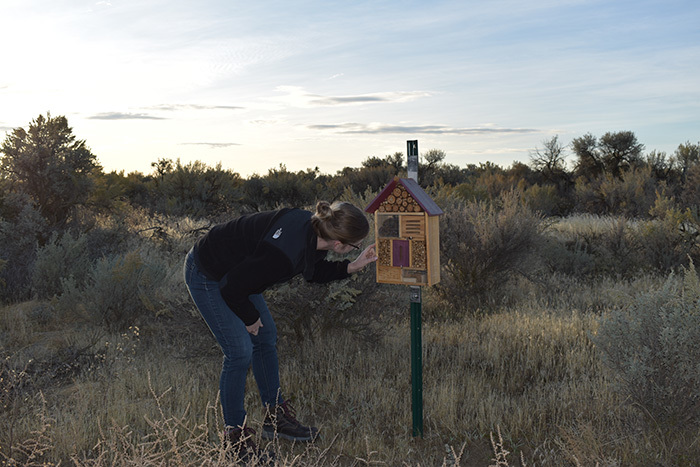 Mission Support Alliance Environmental Scientist Emily Norris checks on the progress of bee nesting in bee boxes recently installed at the Hanford Site.
RICHLAND, Wash. – The EM Richland Operations Office and contractor Mission Support Alliance (MSA) are implementing measures to support pollinating insects on the Hanford Site, the result of ecological monitoring to help ensure the effects of cleanup on wildlife is minimized.
The measures come after a 2017 study sought the best practices to support pollinators. It identified the common types of bees found at Hanford and the habitats they rely on.
Results from that study were used to develop a pollinator-friendly native plant seed mix, which has been used in more than 120 acres of restoration projects on the site.
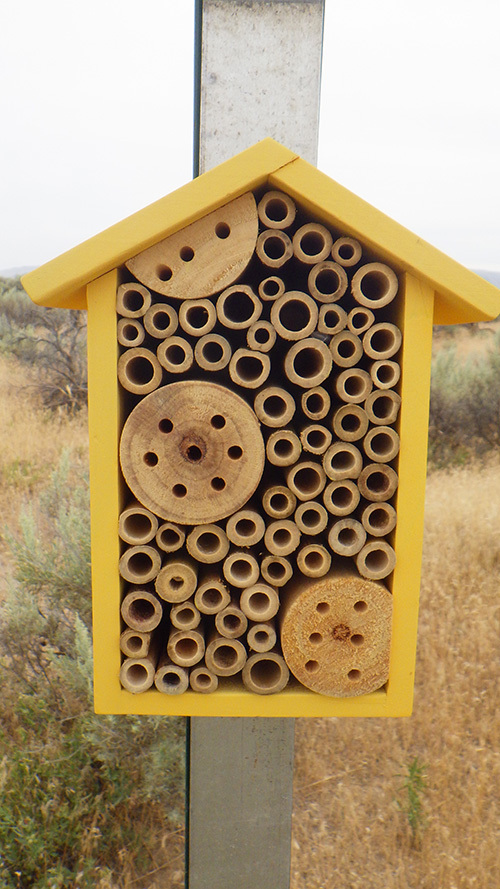 |
|
Workers with Mission Support Alliance recently installed 20 bee boxes as part of habitat mitigation efforts at the Hanford Site. |
The study also identified the need to restore bee nesting habitats in disturbed areas. After a new water line was recently placed across the site’s Central Plateau, crews revegetated disturbed land, and installed 20 bee boxes nearby to provide nesting habitat for leafcutter and mason bees, two bee species common to the site.
“The Department of Energy strives to be an excellent steward of the ecology at Hanford,” said Annabelle Rodriguez with the EM site stewardship division. “When habitats have to be disturbed as part of cleanup work, we perform mitigation actions to benefit the ecology. Installing these bee boxes has allowed us to do just that to ensure we continue to support these important insects at Hanford.”
Bees native to Hanford are typically solitary insects that nest in hollow twigs or wood structures instead of laying eggs in hives. Leafcutter bees are an important pollinator species that helps pollinate the native plants and flowers. Like the well-known honeybee, solitary bees are also experiencing an overall decline in population, so providing these nesting habitats is an important part of species preservation.
Bee boxes at the Hanford Site will support the native bee and native flower populations. Emily Norris, an environmental scientist with Mission Support Alliance’s ecological monitoring and compliance program, is shown at a recently revegetated area near the bee boxes. |
|
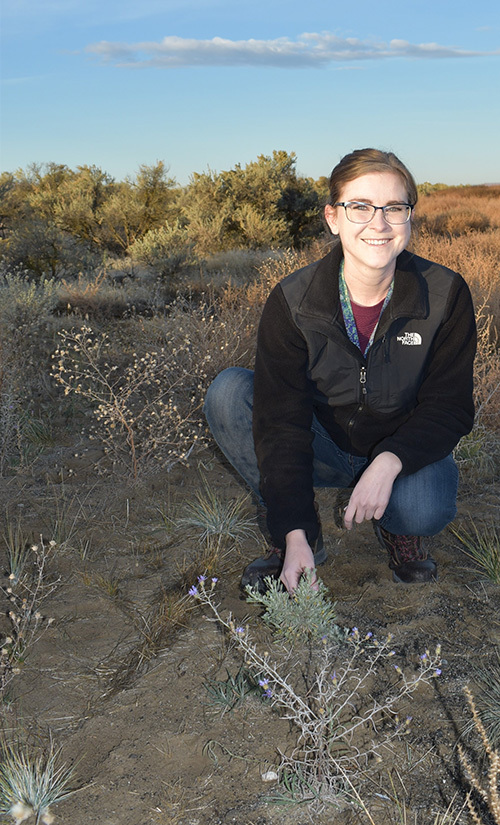 |
The bee boxes are crucial to overall habitat mitigation efforts at Hanford, according to Emily Norris with MSA’s ecological monitoring and compliance program team.
“The boxes were installed next to a recently revegetated site to help increase the abundance of the seeded native flowers,” Norris said. “By supporting pollinators, we’re benefiting all species at Hanford that rely on their services: plants, animals, and more.”
-Contributor: Renee Brooks
MOAB, Utah – DOE recently recognized EM’s Moab Uranium Mill Tailings Remedial Action (UMTRA) Project for excellence in “green purchasing,” procuring products with leading, verifiable sustainability attributes.
“Our project sits along the Colorado River and is adjacent to Arches National Park. Therefore, it’s especially important to us to be as mindful as possible when it comes to the project’s environmental impact, and we work hard to reduce it wherever we can,” Moab UMTRA Project Federal Cleanup Director Russell McCallister said. “We are very proud to receive this award as it reflects our focus on environmental stewardship and effectiveness managing our resources economically.”

The DOE GreenBuy Award Program honored EM’s Moab Uranium Mill Tailings Remedial Action Project for sustainable purchases such as Parry's Penstemon, a native, drought tolerant flower that reduces water consumption. The Moab Project is planting the water-efficient flowers as part of revegetation efforts.
|
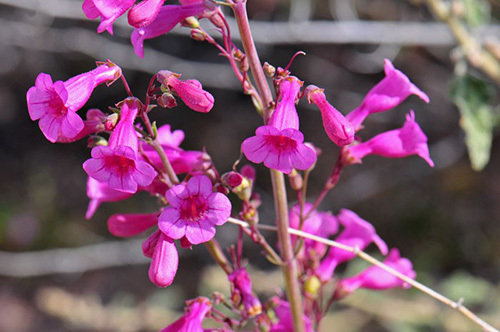 |
|
A close-up view of the water-efficient Parry's Penstemon flowers planted by EM’s Moab Uranium Mill Tailings Remedial Action Project. |
The Department’s GreenBuy Award Program’s priority products list helps DOE sites pinpoint products that, for example, lower health and environmental impacts and reduce waste management costs.
Federal agencies are required to buy goods that are energy and water efficient and made from biobased or recycled content material. The award program recognizes DOE sites that go beyond those requirements.
Sites can qualify for GreenBuy awards at gold, silver, and bronze levels based on their purchase volume in the priority products list categories. The Moab Project achieved the Silver Award for meeting the goals of a minimum of six products in at least three categories. Among the sustainable products purchased by the Moab Project are water-efficient plants for revegetation efforts and sustainable cell phones for employees.
The last time the Moab Project won a GreenBuy award was in 2013. For more information on the awards, and a list of DOE winners, click here.
-Contributor: Honora Thompson
 LAS VEGAS – The EM Nevada Program shared its Operation Clean Desert learning materials with educators at the Nevada State Science Teachers Association conference held Feb. 1 at Rancho High School in Las Vegas. The free materials, including classroom activities, recount the history of the Nevada National Security Site, and discuss the science on how the public and environment are safe from the effects of the site’s historical nuclear testing. Above, Kevin Schmidt, an employee with EM Nevada Program contractor Navarro, talks to teachers about how Operation Clean Desert materials can be used in classrooms.
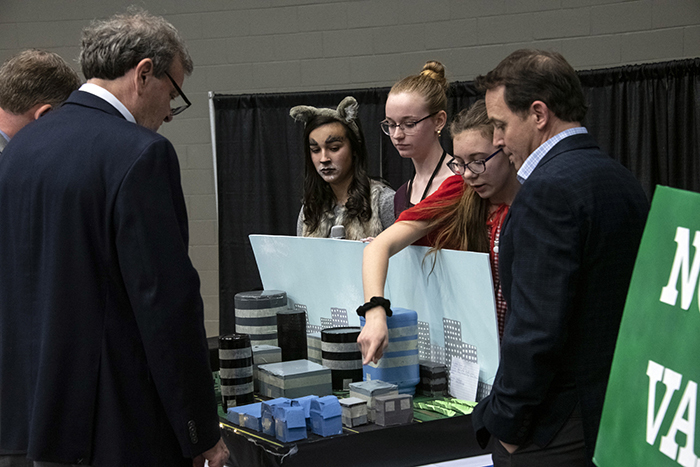 This year’s winning team in the Future City Regional Competition included, from left, eighth-graders Hailey Meteraud, Marissa Wetzel, and Taylor Talavera from Merriwether Middle School in North Augusta, South Carolina. Here, the team makes its presentation to the judges during the final round. The judges include, from left, Daren Timmons, provost and executive vice chancellor of academic affairs, the University of South Carolina Aiken; Dennis Carr, executive vice president and chief operations officer, Savannah River Nuclear Solutions (SRNS); and Chris Harkins, SRNS chief engineer.
AIKEN, S.C. – Forty-three teams of middle school students from across South Carolina built large, complex tabletop models of cities with clean, safe drinking water systems for the recent Future City Regional Competition, as part of an education outreach program managed by an EM contractor at the Savannah River Site (SRS).
“This competition really opened up my mind because I was so surprised by everything engineers do,” said Hailey Meteraud, an eighth-grader at Merriwether Middle School in North Augusta, South Carolina. “All our research showed just how much work is accomplished by engineers, especially nuclear engineering at SRS. And since all of this really interests me, I’ve decided to be an engineer.”
Savannah River Nuclear Solutions (SRNS) employees have managed the local competition for 17 years in partnership with DOE and the Ruth Patrick Science Education Center at the University of South Carolina Aiken. The students participate with 1,500 schools in 39 U.S. regions.
Twenty-nine special awards were presented to select teams in the local competition this year. The first-, second-, and third-place winners were announced after guest judges examined the models and quizzed team members at the daylong event held at the University of South Carolina Aiken.
“Keep in mind that this is definitely not your typical school project,” said Taylor Rice, Future City regional coordinator and SRNS employee. “The students work for months using the engineering design process and project management skills to address solutions to this year’s challenge.”
 From left, Seventh-graders Cody Goldschmidt, Aaron Arnold, and Alex Trippi from Kennedy Middle School in Aiken, South Carolina guide judges Marissa Reigel and Robert Wilson from the organization Citizens for Nuclear Technology Awareness through their model city during the recent daylong Future City Regional Competition at the University of South Carolina Aiken.
The top team — from Merriwether Middle School — received an all-expense-paid trip to compete in the Future City Competition National Finals in Washington, D.C., Feb. 15-19.
Each year, Future City student teams are presented new design challenges, encouraging interest in science, technology, engineering, and math (STEM) education. This year, they were asked to create a system to maintain a reliable supply of clean drinking water in the “Clean Water: Tap into Tomorrow” challenge.
Merriwether Middle School eighth-grader Marisa Wetzel said she enjoys the teamwork and public speaking aspects of this annual competition.
“I’ve never talked in front of a lot of people before. It’s been very helpful,” Wetzel said.
-Contributor: DT Townsend
|